 Ancra Systems BV is the leading specialist in the field of automatic truck (un)loading systems, also known as ATLS. Ancra offers both standard and customized ATLS solutions, geared to different industries and calculated to meet customers’ specific logistics requirements. With 20 years’ experience, Ancra Systems has become market leader in Europe in this specialist field.
Ancra Systems BV is the leading specialist in the field of automatic truck (un)loading systems, also known as ATLS. Ancra offers both standard and customized ATLS solutions, geared to different industries and calculated to meet customers’ specific logistics requirements. With 20 years’ experience, Ancra Systems has become market leader in Europe in this specialist field.
Ancra Systems were recently awarded Logistics Innovation of 2011 by the Polish logistics magazine, Eurologistics, for the automated loading and unloading solution they installed at H&B Logistics in Den Bosch, The Netherlands, the logistic centre for the nearby Heineken brewery. This Innovation award from the Polish logistics industry was especially important for Ancra, since they have been focusing for the last year on developing their links with the rapidly growing logistics market in developing economies like Poland. Jasper van den Driest, Ancra Systems BV Managing Director, spoke to Warehouse & Logistics News.
Warehouse & Logistics News – First question – Jasper, what is your day-to-day role in Ancra Systems?
I see my primary role being to create the right conditions and environment for our employees to do their job in the best way possible. Customers will notice the difference, and benefit as a result. I am convinced that a company can only become successful over the long term by having personnel who are professional and empowered.
WLN – Do you go to see clients and devise solutions for them?
Yes, I spend a fair amount of time dealing directly with customers. Coming from a business background, I tend to focus first on the financial feasibility of potential projects. If there is a strong case for automated loading and unloading, it is up to our technical department to come up with the optimum technical design.
WLN – Who are the other senior people in the business?
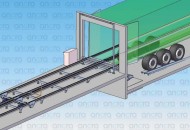 We have a very experienced management team, with both our Technical and Sales Manager having over 20 years’ experience and our Operations Director over 10 years. I am actually the rookie, being involved in the business for only four years.
We have a very experienced management team, with both our Technical and Sales Manager having over 20 years’ experience and our Operations Director over 10 years. I am actually the rookie, being involved in the business for only four years.
WLN – In non-technical terms, what exactly are automatic truck loading systems?
Most common automatic truck loading and unloading requires two ‘combined’ systems: one system in the trailer, and a ‘fixed’ installation inside the loading and unloading dock, for the maximum efficiency. When a trailer docks, the entire load is loaded or unloaded automatically and loading/unloading time is reduced from half an hour or more to just two minutes.
WLN – What size and type of trailers are suitable for fitting with ATLS?
We are able to build our systems in almost any trailer, both new and used. However we have standardised systems for standard trailers, which give the best cost–benefit ratio.
WLN – How much does a trailer conveyor cost, compared to the price of a trailer?
Nowadays we often supply the system with the trailer as a turnkey project. By standardising our designs for chain and slat conveyor systems, the trailers need minimal modification. The combination of a new trailer and system starts at about 50,000 Euros, and goes up to about 65,000, depending on the type of system and the different options. These price levels are substantially lower than just a couple of years ago, when special trailers were required and systems were not yet standardised.
WLN – Do you contract hire your conveyors or sell them outright?
We have developed financial lease options in cooperation with a trailer leasing company. We lease the trailer from the leasing company; we install the system and lease the complete package to the end customer. We can also provide trailers with systems installed in full operational lease, but this requires a thorough understanding of the specific application, and is therefore not a standard option.
WLN – Do you have any formal links with trailer manufacturers or distributors, or are you free to fit your conveyors to any make of trailer?
We can work with any trailer manufacturer. Of course we can advise and have our preferences, based on past experience, but our motto is always let the customer decide.
WLN – Who are Ancra Systems?
Ancra Systems originated as a division of Ancra International, a US supplier of load securing products. The systems division developed into a business of their own, which is a technical projects activity focused on production companies rather than a supplier of lashings and so on to the transport industry. For this reason Ancra Systems was sold off in the ‘90’s, and nowadays Ancra Systems is privately owned, with the majority of the shares with management. This ensures a long-term focus and high level of commitment.
WLN – How big is Ancra Systems?
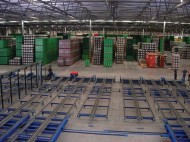 We currently have a staff of 23 full time employees. In case of large projects, we hire temporary staff to increase our capacity.
We currently have a staff of 23 full time employees. In case of large projects, we hire temporary staff to increase our capacity.
WLN – Which countries are you active in?
Traditionally we have been active all over Europe, but in recent years we have supplied systems worldwide, in countries such as China, Taiwan and Russia. We will start 2012 with a large project in Brazil, which will open up another market for us.
WLN – Where do you manufacture your systems?
In general, we design, and manufacture our systems in our facility in Boxtel, The Netherlands. When supplying systems outside of Europe, we also have the option to have local partners assemble the systems, but always based on Ancra design and with Ancra quality control.
WLN – What type of logistics operations are suitable for automated truck loading?
Automated Truck Loading Systems can operate in all kinds of industries, including FMCG, automotive, industrial applications and air cargo. The ATLS system contributes most of all to those applications that have high volumes being transported by shuttle over short distances.
WLN – What are the benefits of having such a system?
The main benefit is the strongly reduced ‘truck turn around time’, which results in less trailers, trucks and drivers being needed to transport the same amount of cargo. Secondly, there are substantial internal logistics savings; no more need for loading and unloading personnel and related equipment, and fewer loading and unloading docks, because each dock can handle higher volumes. A third category of benefits, which can be very important but are more difficult to quantify is less product damage, a safer work environment and more efficient use of building and outside space, due to a more concentrated flow of goods.
WLN – When would ATLS be justified economically?
Usually this is the case in an operation with short distance, high volume shuttle transportation. Let me give an example: driving time one way is 20 minutes, and the conventional loading and unloading time is 35 minutes. So the total cycle time is 110 minutes. Let’s say that automated loading and unloading take about 5 minutes each, including docking, checking papers and so on. The new cycle time will be about 50 minutes. The same amount of product will be transported with half the number of trucks, trailers and drivers.
WLN – What happens if you’re not able to have a fixed system at the loading bay or unloading bay? Can you still load or unload trailers that have conveyors on them?
You are right: sometimes a fixed system cannot be installed at the loading or unloading side, because of lack of internal space, or due to multiple loading or unloading points. In this case, significant savings can still be realised by index loading or unloading by forklift truck. In case of index loading, the forklift can place the pallets at the back of the trailer, and the system will index each row of pallets into the trailer. This way, the forklift does not have to enter the trailer, which is a significant time saver. The same saving applies when unloading without a fixed system.
WLN – Can your loading and unloading conveyors link up to other automated handling systems within a warehouse or distribution centre?
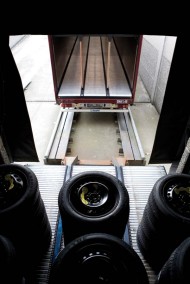 Yes, we often connect our loading systems to feeding conveyors, which are directly linked to production lines. On the warehouse side, we often connect to internal conveyors that are linked to automated pallet storage systems. These types of applications really fulfil the ambition of fully automated supply chains. Alternatively, staging and unstaging of pallets can be done by AGV’s as well.
Yes, we often connect our loading systems to feeding conveyors, which are directly linked to production lines. On the warehouse side, we often connect to internal conveyors that are linked to automated pallet storage systems. These types of applications really fulfil the ambition of fully automated supply chains. Alternatively, staging and unstaging of pallets can be done by AGV’s as well.
WLN – What kinds of goods can be handled automatically?
Over the years we have developed solutions for a wide range of products, ranging from palletised goods to non-palletised, and from air cargo pallets to loose loaded parcels. Among others, these products include beverages, sets of wheels, loose loaded parcels and packages, fresh and frozen vegetables and other frozen products, consumer durables and electronics, and even drugs or clothing for the medical industry that require special solutions due to sterilisation. These systems can successfully manage heavy weights, large diameter materials and products subject to fragility or needing special temperature conditions.
WLN – How does the system work with non-palletised goods?
We have different technical solutions for these kinds of applications, but most commonly we use a ‘slat conveyor’ system, which creates a full carrying surface over which non-palletised products such as sets of tyres, slip sheets, racks or mixed pallets can be transported.
WLN – What is the maximum weight load these conveyors can bear?
Our standard systems have a capacity of 30 tonnes, but we have built heavy-duty versions capable of up to 40 tonnes.
WLN – What different kinds of systems do you supply?
We supply chain conveyor systems, belt conveyor systems, slat conveyor systems, skate systems, roller track systems and specials, engineered to customer specifications.
WLN – If a trailer is damaged in a crash or burnt, can the conveyor be retrieved and repaired?
Yes, they can. We have a professional service department dedicated to aftermarket service. However, since our systems are designed to be as technically robust as possible, the service and maintenance required is minimal. Therefore, many systems are in operation for over 10 years.
WLN – What are the safety aspects of ATLS systems?
Ancra ATLS systems are designed and built according to the highest safety standards defined in the European Machine Guideline. By automating the loading and unloading process, both damage and injury rates fall drastically. The commonly used 13.6 m trailers are automatically loaded within 2.5 minutes. The tractor unit will usually stay connected to the trailer, so securing a trailer against tilting is not necessary. As forklift trucks no longer enter the trailer with an ATLS system in place, there is no risk of them falling off the loading dock, or of forklifts damaging either the trailer or the loaded products.
WLN – Does Ancra have a UK office? Do you supply your systems here direct or through distributors? Who are your UK representatives?
We do not have a separate sales office in the UK, since it is just an hour’s flight from Amsterdam and all our personnel are fluent in English. We are flexible and pragmatic; we let the customer decide what structure is best suited for their project. In the UK we have supplied to system integrators, like Conveyor Networks, and we have supplied directly to customers with the help of a local agent, like European Conveyors.
WLN – Which industry sectors are your customers in?
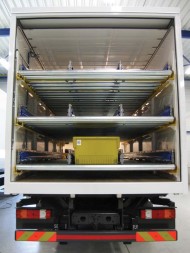 To date we have installed systems in a wide range of industries – post and parcels, FMCG, automotive, consumer durables, health care, industrial, paper and airfreight.
To date we have installed systems in a wide range of industries – post and parcels, FMCG, automotive, consumer durables, health care, industrial, paper and airfreight.
WLN – Can you tell us about some of your major customers, and what you have done for them?
We have built up an impressive reference list over the years, with different types of systems for different industries, on different continents. The list includes A-list companies like Heineken, Unilever, P&G, Volvo, Audi, Sony, DHL, LaPoste and many others.
WLN – Speaking of Heineken, can you tell us about the award winning automated loading and unloading solution you installed for them at H&B Logistics in Den Bosch in The Netherlands?
Den Bosch is the logistics centre for the nearby Heineken brewery. Our highly innovative solution consists of a combination of eight automatic loading systems that allow loading/unloading in just 2.5min. The staging and unstaging of the pallets onto and off the systems is done by AGV’s. The combination of the Ancra systems and the AGV’s results in a fully automated beverage warehouse solution, whose complexity and size make it one of the world’s most advanced automatic truck loading and unloading systems.
WLN – You’ve spent the past year developing your links with the Polish logistics market. What major projects have you been involved with there?
 So far we have installed systems for a supplier to a large automotive company, but expect to have more success in 2012, especially in the food and beverage industry.
So far we have installed systems for a supplier to a large automotive company, but expect to have more success in 2012, especially in the food and beverage industry.
WLN – Can you tell us about your UK customers to date? Are there any reference sites that people can come and see here?
When studying the UK market a couple of years ago, we found people were already quite familiar with this type of technology, but there were very few suppliers. Since then we have started to focus actively on the UK, and been successful. To date we have supplied systems to UK-based customers including Unilever, Sterigenics, DHL and Partner Logistics.
WLN – How long does it take to supply and install your conveyors?
This usually takes 10 to 12 weeks from order to commissioning.
WLN – Do you provide servicing and maintenance?
Yes we do. All our systems are engineered to require very little service and maintenance, but should it be necessary we have a team of 10 mechanical and electrical trained technicians who can provide all aftermarket services. We have developed both maintenance and service contracts, and have a 24-hour hotline. To organise service and maintenance abroad efficiently, we use a multiple tier approach. Tier 1 is customer support staff: Tier 2 is Ethernet access and remote monitoring; Tier 3 is local on site support from one of our service partners; and Tier 4 is on site support from Ancra personnel, who arrive within 24 hours. In the key markets outside Benelux, we have appointed representatives who can provide local technical and administrative support.
WLN – What effect have the difficult economic conditions had on demand for your systems?
The effect has been mixed. On the on hand many capital investments were postponed; on the other hand, we sense much more interest in logistic automation.
WLN – Finally, what are your plans for Ancra Systems in 2012?
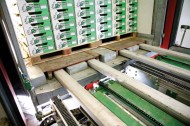 Next to maintaining our current growth path, we are in the final stages of developing a loading system that does not require any modifications of trailers. We intend to install the prototype at a customer for an extensive operational test in the first half of 2012. If all goes well, it will be a great technical breakthrough in our industry, and you will be the first to know!
Next to maintaining our current growth path, we are in the final stages of developing a loading system that does not require any modifications of trailers. We intend to install the prototype at a customer for an extensive operational test in the first half of 2012. If all goes well, it will be a great technical breakthrough in our industry, and you will be the first to know!
Ancra Systems BV
Tel: 0031 411 677 865




Comments are closed.